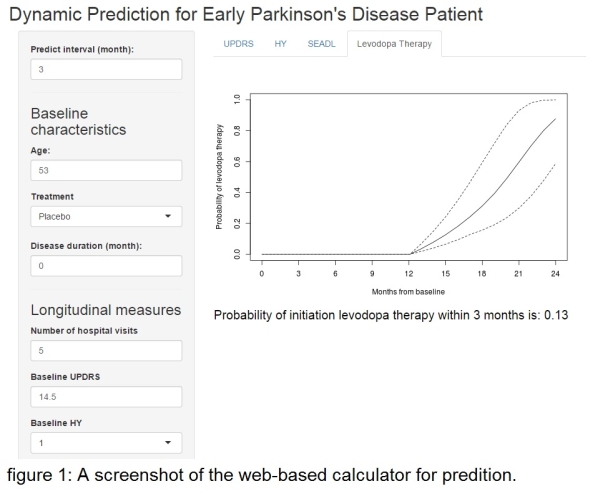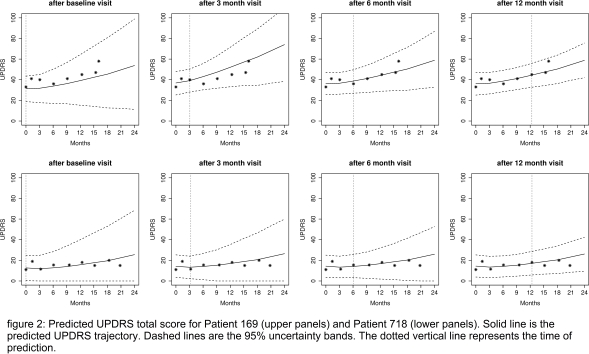Session Information
Date: Thursday, June 23, 2016
Session Title: Parkinson's disease: Clinical trials, pharmacology and treatment
Session Time: 12:00pm-1:30pm
Location: Exhibit Hall located in Hall B, Level 2
Objective: To develop methods for model-based personalized dynamic prediction of future outcome measure trajectories and risks of target events for the Parkinson’s disease patients.
Background: The multiple longitudinal outcome measures (e.g., UPDRS and Hoehn and Yahr) collected in many PD studies are predictive of de novo PD patients’s disease progression and initiation of symptomatic therapy. We developed a novel statistical methodology for personalized dynamic predictions of future outcome measure trajectories and risk of symptomatic therapy at every time point given the subject-specific outcome measure profiles. These important predictive measures are highly relevant for PD patient targeting, management, prognosis, and treatment selection.
Methods: We developed a novel dynamic prediction framework that consists of: (1) a latent trait linear mixed model for the multiple longitudinal outcomes with a univariate latent variable representing the underlying PD severity, and (2) a survival model for the time to symptomatic therapy data. We developed and deployed an open-source web-based calculator  to produce time-dependent predictions of future outcome measure trajectories (with standard errors and uncertainty bands) and the probabilities of symptomatic therapy. A key feature of the dynamic prediction framework is that the predictive measures can be dynamically updated as additional longitudinal measurements become available for the target subjects, providing instantaneous risk assessment. We applied our method to the DATATOP study as an illustration.
to produce time-dependent predictions of future outcome measure trajectories (with standard errors and uncertainty bands) and the probabilities of symptomatic therapy. A key feature of the dynamic prediction framework is that the predictive measures can be dynamically updated as additional longitudinal measurements become available for the target subjects, providing instantaneous risk assessment. We applied our method to the DATATOP study as an illustration.
Results: Both the simulation studies and the application to the DATATOP study indicated that our method can efficiently utilize the multivariate longitudinal outcome measures and the survival data to make correction predictions for new PD patients  . When new measurements are available, predictions can be dynamically updated and become more accurate and efficient.
. When new measurements are available, predictions can be dynamically updated and become more accurate and efficient.
Conclusions: Our dynamic prediction framework and the translational web-based calculator provide a useful supplemental tool for physicians to monitor patients’ disease progression and make informed decisions on therapy selection and for patients to better manage risks.
To cite this abstract in AMA style:
S. Luo, J. Wang. Dynamic prediction for multiple repeated measures and event time data: An application to Parkinson’s disease [abstract]. Mov Disord. 2016; 31 (suppl 2). https://www.mdsabstracts.org/abstract/dynamic-prediction-for-multiple-repeated-measures-and-event-time-data-an-application-to-parkinsons-disease/. Accessed December 22, 2025.« Back to 2016 International Congress
MDS Abstracts - https://www.mdsabstracts.org/abstract/dynamic-prediction-for-multiple-repeated-measures-and-event-time-data-an-application-to-parkinsons-disease/
